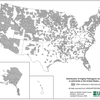Local nursing-home workers picket as part of statewide push for reform
GUILDERLAND — On March 18, some dozen health-care workers gathered in the rain outside The Grand Rehabilitation and Nursing at Guilderland to protest working conditions they say result in lower quality care for residents, and to voice support for legislation proposed by Governor Andrew Cuomo that would address transparency, accountability, and profit-seeking in nursing home management offices.
Organized by 1199 Service Employees International Union United Healthcare Workers East, the protest was one aspect of a statewide push for action following a report issued by state Attorney General Letita James on Jan. 28 that laid out the factors contributing to COVID-19 nursing home deaths in New York State, including chronic understaffing, and the failure of some for-profit facilities to use outside funding for personal protective equipment and testing, instead using it to increase revenue.
The Grand at Guilderland, a for-profit facility operated by The Grand Healthcare System, based in Long Island with 16 nursing homes across the state, suffers from chronic understaffing, according to workers who spoke with The Enterprise last week, as well as the United States Centers for Medicare and Medicaid Services, which rates nursing homes and other healthcare facilities on a five-star scale according to staffing, health and safety practices, and quality of resident care.
As of March 11, The Grand at Guilderland had an overall rating of one star, which is defined as “much below average,” and a particular rating of four stars for quality of resident care, one star for health and safety, and two stars for staffing.
For workers like Raffaele Hayden, a certified nurse’s assistant who has worked at the Guilderland Center nursing home for 20 years — The Grand Healthcare System took over management of the facility in 2014 — that means spending weekends caring for dozens of residents with just one nurse, which is why she joined her colleagues to protest those practices.
“It’s a lot,” Hayden told The Enterprise last Thursday. “You can’t give the residents the care you want to give them because you’re working by yourself. Especially on the weekends … I’m in one direction, the nurse is in the other direction.”
Bruce Gendron, regional administrator for The Grand Healthcare System, did not return repeated calls from The Enterprise.
The CMS website states that The Grand at Guilderland has, on average, 116.5 residents per day, with the licensed nurse staff spending one hour and 24 minutes per resident per day, compared to the state average of one hour and 36 minutes.
Nurses’ assistants spend one hour and 26 minutes per resident per day, compared to the state average of 2 hours and 13 minutes. Physical therapists spend 13 minutes per resident per day, compared to the state average of 7 minutes.
Nurse’s assistant Andrea Gonzalez, who is also a union delegate, asked rhetorically how staff can do their jobs appropriately when stretched so thin.
“If you work with one nurse and one aide, how are you going to do [the job]?” she said. “If you have 10 residents who cannot feed themselves and you only have one aide and one nurse, how is it OK?”
Gonzalez blames the understaffing on stinginess. She said The Grand’s management are trying to “put more money in their pocket instead of the caregiver’s,” which in turn contributes to high turnover.
“You work your ass off for little pay,” agreed Darlene Pierce, a licensed practicing nurse.
Gonzalez said that nurse’s assistants make around $13 an hour, which she compared to the higher pay that part-time employees can get at some fast-food restaurants. The current minimum wage for upstate New York is $12.50.
“Other places are paying more than health-care [facilities],” Gonzalez said.
When asked what she thought a fair wage would be for the work, she said, “What do you think? More than that. A whole lot more. It’s physical work … Flipping burgers is physical work, too, but this is caring for adults.”
Legislation
Cuomo announced his nursing home reform package on Feb. 19, shortly after the release of the attorney general’s report, which had elicited immediate and cascading criticisms of his handling of nursing homes during the pandemic.
The attorney general’s investigation had found more nursing-home residents died of COVID-19 than data from the state’s health department reflected.
The investigation also found that government guidance requiring the admission of COVID-19 patients into nursing homes may have put residents at increased risk of harm in some facilities and may have obscured the data available to assess that risk.
Cuomo’s proposal, which would be accepted as part of the state budget, tackles three major themes of the report, which are financial transparency, operator accountability, and prioritizing profit over patient care.
To increase financial transparency, the legislation would require nursing homes to:
— Post “their rates of each payer source on a public website, updated annually”;
— Post facility owners;
— Post “a list of all contracts or other agreements entered into for provision of goods or services for which any portion of Medicaid or Medicare funds are used by the facility within 30 days of execution of the agreement”; and
— Include information about staffing on applications to establish a nursing home.
To hold operators accountable for misconduct, the legislation would:
— Increase the civil penalty for Public Health Law violations to $25,000, with higher fees for willful violations;
— Remove a 30-day grace period enjoyed by facilities prior to the imposition of a fine;
— Require “any nursing home with a repeat Infection Control Deficiency to work with the Quality Improvement Organization, or a state designated independent quality monitor, at the nursing home's own expense, to assess and resolve the facility's infection control deficiencies”; and
— Improve the process by which a receiver is appointed to protect patient health and safety.
And, to ensure that patient care doesn’t suffer in the pursuit of profit, the legislation would:
— Require that “nursing homes spend a minimum of 70 percent of revenue on direct patient care and a minimum of 40 percent of revenue on resident staffing”;
— Establish a profit cap and limit “certain unscrupulous transactions, including but not limited to related party transactions over fair market value and payment of compensation for employees who are not actively engaged in or providing services at the nursing home”; and
— Cap the size of management salaries based on the size of the facility.
The State Legislature has also passed at least six bills related to nursing homes, most of which have yet to be signed by the governor, and five more await votes in one or both chambers. The one that’s been signed adds various requirements that need to be met by nursing home facilities before they discharge patients, stemming from incidents where nursing homes released patients into the care of homeless shelters and other facilities that didn’t necessarily have the resources to continue appropriate care for those patients.
Bills awaiting the governor’s signature include one that would study the state of long-term care services in New York, one that allows for “compassionate caregiving visitors within nursing homes,” one that requires CMS ratings to be displayed prominently on nursing home website landing pages, one that would improve infection control, and one that provides information on where a list of violations and “other actions taken against the facility” can be found.
“There have been many bills introduced in the State Legislature under the guise of ‘nursing home reform,’” said Stephen Hanse, president and chief executive officer of the New York State Health Facilities Association and the New York State Center for Assisted Living, which represents over 425 skilled nursing and assisted-living providers, in a March 15 statement.
“Whether it’s the requiring 70 percent of revenues be allocated to direct care or implementing studies or increasing fines, not one of these bills truly improves quality outcomes or addresses the two most important issues facing nursing homes in our state, namely New York’s long-term care workforce staffing crisis and the state’s 12-plus years of slashing over $2 billion in Medicaid funding to nursing homes,” Hanse went on.
Going into the pandemic, Hanse said, nursing homes were struggling to recruit and retain workers. Then providers lost more staff due to illness and workers staying home to care for their children when schools were closed.
He cited workforce shortages documented in the SUNY Center for Health Workforce Studies 2020 Report and the Department of Health August 2020 minimum staffing report prepared by Cornell University.
Hanse concluded, “Almost 80 percent of New York’s nursing home resident care is reimbursed by Medicaid. The average cost of providing 24-hour nursing home care in New York is $266 per resident per day, but the State only pays an average of $211 per resident per day — or $8.79 per hour! This $55 Medicaid shortfall is the largest in the nation and directly impacts a nursing home’s ability to retain workers when hospitals can always pay nurses more.”



